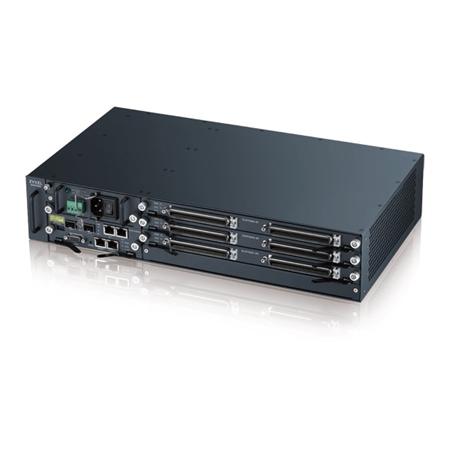Zyxel IES4105M, 2U TEMPERATURE-HARDENED 4-SLOT CHASSIS MSAN WITH DC POWER MODULE (48V DC INPUT) & FAN MODULE
Výrobce
Zyxel
Part No.
IES4105M-ZZ01V3F
Kód
785953
Zyxel IES4105M Chassis MSAN System Specifications DSL Compliant ADSL: Support dual stack (IPv4 and IPv6) Auto or fixed operation as either one of the following: ADSL2, ADSL2+, G.dmt, T1.413, G.lite OAM loopback: both CO to CPE and CPE to CO Freq
DPH
21%
14 351 Kč s DPH
11 860 Kč bez DPH
Dostupnost
Záruka
2 Roky
Zařazení produktu
Související dokumenty








Podrobnosti o produktu
System Specifications
DSL Compliant
ADSL:
Support dual stack (IPv4 and IPv6)
Auto or fixed operation as either one of the following: ADSL2, ADSL2+, G.dmt, T1.413, G.lite
OAM loopback: both CO to CPE and CPE to CO
Frequency allocation band plan 998 and 997
8 PVC per port
G.992.1, G.992.3, G.992.5
Latency path function in G.992.3 and G.992.5
Annex L and Annex M in G.992.3 and G.992.5
Loop diagnostic in G.992.3 and G.992.5
Power management mode by TR-202
Power management L0 and L2 mode. Parameters support: L0Time, L2Time, L2ATPR, L2ATPRT in G.992.3 and G.992.5
Seamless Rate Adaptation (SRA: Fix rate, Startup, Runtime) on-line configuration in G.992.3 and G.992.5
Reach extension ADSL (Annex L, RE-ADSL2)
Loop Diagnostic Mode (LDM, DELT)
Single End Loop Test (SELT)
Double upstream (Annex M)
VDSL2:
Support Annex Y in G.993.2
G.993.5, G.998.4, G.993.2, G.994.1, G.997.1
Support profile 8a, 8b, 8c, 8d, 12a, 12b, 17a and ADSL/ADSL2/ADSL2+ fall back
Support VDSL bonding
VoIP:
ITU-T H.248 v2 or RFC3261 SIP v2
Codec: G.711 (µ-law and A-law), G.726, G.729a/b, G.723.1
RTP (RFC1889)
RTCP (RFC1890)
RTP payload for DTMF digits (RFC2833)
Echo cancellation and auto gain control (G.165, G.168)
Voice Activity Detection (VAD)
Comfort Noise Generation (CNG)
Caller ID generation
Metallic Loop Testing for subscriber lines (MLT)
Configurable jitter buffer
Certified POTS phone with individual country code signaling
Certified Fax machine with T.30, T.38
Certified analog dial-up modem
Certified pay phone with battery (polarity) reversal, 12 KHz or 16 KHz charging signal
Certified POS terminal
Dial tone, second dial tone, ringing tone (ringback tone), busy tone, off-hook, warning tone
Supplementary services
Emergency call local route
Do not disturb
Selective/anonymous call rejection
Call waiting and call hold
Call transfer (blind and attended transfer)
Call return and call back on busy
Off hook warning tone
Warning tone
Calling Line Identification Presentation (CLIP)
Calling Line Identification Restriction (CLIR)
Abbreviated dialing (speed dial)
Hotline (H.248)
Local dial (SIP only)
IPTV
512 IGMP groups
IGMP v3 any source multicast
IGMP group fast leave
IGMP message count control
MLD v2 any source multicast
IP multicast forwarding
Multicast VLAN (4 VLANs)
IGMP multicast channel limiting by count/bandwidth usage
Multicast membership reports
IGMP privilege profile
Broadcast/Multicast/Destination lookup fail storm control and configurable the limit number
Security
DHCP spoofing with static IP filtering
Anti-MAC spoofing & ARP inspection (both can be enabled at the same time)
Upstream ACL mechanism: up to L4 packet classification based on IP source/destination address, protocol ID, UDP/TCP source/destination port number and action definition
Static MAC address filtering by source/destination
ARP/DHCP broadcast filtering
NetBios filtering
IGMP/BPDU filtering
L2 frame filtering, such as based on source MAC address, port etc.
PPPoE filtering
Layer 3 filtering based on IP header: source addresses, destination addresses, protocol ID, UDP/TCP port number
L2 frame filtering based on OUI
IPv6 packet classification
L2 filtering based on Ether type, source/destination MAC address
Static MAC address forwarding/port lock
Anti MAC/IP address spoofing (DHCP snooping)
Limitation of number of dynamic learned MAC address on per subscriber port
Ethernet MAC filtering
Secure FTP
VLAN
VLAN transparent (802.1D; except for VLAN stacking TLS mode in a port/PVC)
IEEE 802.1Q VLAN tagging
VLAN trunk
VLAN translation (8 rules per port/PVC)
VLAN aggregation (4 rules per port/PVC)
IEEE 802.1ad VLAN stacking (Outer TPID configurable, selective QinQ; VLAN stacking TLS mode cannot coexist with VLAN transparent in a port/PVC)
Limited MAC per DSL port
At least 1024 VLAN ID
Able to accept untagged frame from CPE
IEEE 802.1p priority que; at least 8 per uplink
Protocol-based VLAN
Port isolation
Broadcast storm control
Performance
Eight queues with packet priority scheduling (SPQ, WRR)
Support 1024 IGMP multicast groups
The maximum channel zapping processing time is 250 ms
DSCP to 802.1p mapping
ATM Traffic Management
Support 8 PVC per DSL port
Support UBR, CBR, rt-VBR, nrt-VBR, QoS mechanisms
Support ATM Forum TM 4.0 peak cell rate traffic parameter
Support downstream traffic shaping function per ATM PVC
Support ATM F5 OAM cells for end-to-end loop back test (ITU-T Rec. I.610)
Traffic Management
IEEE 802.3ad (link aggregation; LACP, GE uplink only)
IEEE 802.1d (Spanning tree)
IEEE 802.1w (Rapid spanning tree protocol)
PPPoE
PPPoEIA
DHCP (Snooping, relay & option 82)
LAN to LAN (Transprent LAN service; TLS)
IEEE 802.1p priority que:
Configurable based Strict Priority Queuing (SPQ) or Weighted Round Robin (WRR)
DSCP code to 802.1p priority mapping
PVC default priority
OAM F5 loopback
Performance counters
Performance statistics (15m)
DHCPv6 L2 relay agent
Support dual stack (IPv4 and IPv6)
MTU size up to 1600
Rate limiting
Upstream broadcast storm control
Network Management
DDMI readout for each uplink port (SFP dependent)
FTP for firmware upgrade, via MSC or via console
Dual image for smooth FW upgrade
Text-base configuration through console port and telnet (CLI)
Daylight saving
Configurable TPID
Private MIB
RFC1213 MIB II Management Information Base for Network Management of TCP/IPbased internets
RFC5650 VDSL2 line MIB
Hardware Specifications
IES4105M
Four slots for hot-swappable line cards
One slot for management & uplink card
One slot for AC, DC or dual power module
One slot for hot-swappable FAN module
2G backplane switching capacity per line card slot
2U in height
Rack-mountable for 19-inch rack
Front access (all interface, including all line cards, power and FAN modules)
REN: 15
Grounding terminal
Management Switch Card— MSC1002GA
Two Gigabit combo ports
DDM readout
2G switching capacity to each line card slot
ADSL Line Card—ALC1132A-51
Thirty-two ADSL+POTS subscriber ports via one champ-64 connector
Thirty-two POTS splitter input ports via one champ-64 connector
Annex A
Built-in POTS splitter that supports both 600 and 900 ohm
Hot-swappable
VDSL Line Card—VLC1124A-51
G.993.2, G.994.1, G.997.1
Twenty-four VDSL+POTS subscriber ports via one champ-64 connector
Twenty-four POTS splitter input ports via one champ-64 connector
Annex A
Built-in POTS splitter that supports both 600 and 900 ohm
Hot-swappable
VoIP Line Card—VOP1164A-61
Sixty-four voice subscriber ports via two champ-64 connectors
Hot-swappable
Loop current:
25 mA MAX
?20 mA at 800 ohm loop resistance
Power Consumption
IES4105M+MSC1002GA+IES4105M-ACA: 37.18W
ALC1132A-51: 33W
VLC1124A-51: 27.83W
VOP1164A-61: 104.58W